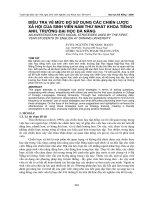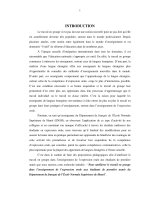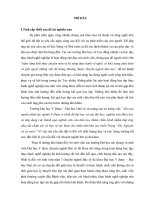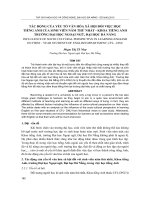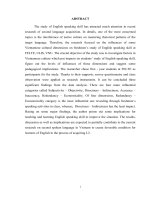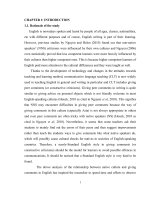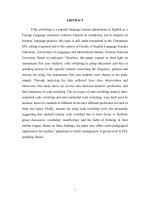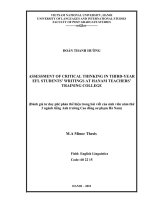MỘT vài yếu tố văn hóa ẢNH HƯỞNG đến VIỆC học nói của SINH VIÊN năm THỨ NHẤT NGÀNH TIẾNG ANH sư PHẠM TRƯỜNG đại học NGOẠI NGỮ đại học QUỐC GIA hà nội
Bạn đang xem bản rút gọn của tài liệu. Xem và tải ngay bản đầy đủ của tài liệu tại đây (492.85 KB, 86 trang )
ABSTRACT
The study of English speaking skill has attracted much attention in recent
research of second language acquisition. In details, one of the most concerned
topics is the interference of native culture on mastering rhetorical patterns of the
target language. Therefore, the research focused on the influences of some
Vietnamese cultural dimensions on freshmen’s study of English speaking skill at
FELTE, ULIS, VNU. The crucial objective of the study was to investigate factors in
Vietnamese culture which put impacts on students’ study of English speaking skill,
figure out the levels of influences of those dimensions and suggest some
pedagogical implications. The researcher chose first - year students at FELTE as
participants for the study. Thanks to their supports, survey questionnaire and class
observation were applied as research instruments. It can be concluded three
significant findings from the data analysis. There are four main influential
categories called Subjectivity – Objectivity, Directness – Indirectness, Accuracy –
Inaccuracy, Redundancy – Economicality. Of four dimensions, Redundancy –
Economicality category is the most influential one revealing through freshmen’s
speaking activities in class, whereas, Directness – Indirectness has the least impact.
Basing on some major findings, the author points out some implications for
teaching and learning English speaking skill to improve the situation. The results,
discussion as well as implications are expected to partially contribute to the current
research on second spoken language in Vietnam to create favorable condition for
learners of English in the process of acquiring L2.
i
TABLE OF CONTENTS
Acknowledgements......................................................................................................i
Abstract..................................................................................................................ii
List of figures and tables.......................................................................................vii
List of abbreviations..............................................................................................viii
CHAPTER 1: INTRODUCTION.......................................................................1
1.1. Statement of the problem and the rationale of the study...............................1
1.2. Aims and objectives of the study...................................................................2
1.2.1. Aims of the study.........................................................................................2
1.2.2. Objectives of the study................................................................................2
1.3. Significance of the study.................................................................................2
1.4. Scope of the study..........................................................................................3
1.5. Organization....................................................................................................3
CHAPTER 2: LITERATURE REVIEW..........................................................5
Key concepts.........................................................................................................5
2.1. Culture………………………………………………………………………5
2.1.1. Definition of culture………………………………………………………5
2.1.2. Language and culture……………………………………………………..6
2.1.2.1. Language and culture in general……………………………………….6
ii
2.1.2.2. Language and culture in language acquisitions…………………………...8
2.2. Communication...................................................................................................9
2.2.1. Definition of communication……………………………...............................9
2.2.2. Functions of communication………………………………………………...9
2.2.3. Types of communication…………………………………………………….9
2.2.3.1. Verbal communication……………………………………………………11
2.2.3.2. Non – verbal communication……………………………………………..11
2.2.4. Cross – cultural communication……………………………………………12
2.3. Some key categorical dimensions in cross – cultural communication……...12
2.3.1. Subjectivity – Objectivity…………………………………………………..13
2.3.1.1. The use of prepositions…………………………………………………...14
2.3.1.1.1. Prepositions of movement with directional verbs……………………..14
2.3.1.1.2. Locative prepositions…………………………………………………...15
2.3.1.2. The use of passive voice………………………………………………….16
2.3.2. Directness – Indirectness……………………………………………………17
2.3.3. Accuracy – Inaccuracy……………………………………………………...19
2.3.3.1. The use of tenses…………………………………………………………..19
2.3.3.2. The use of genitive indicators……………………………………………20
2.3.4. Redundancy – Economicality……………………………………………....21
iii
2.3.4.1. Redundancy………………………………………………………………21
2.3.4.2. Economicality………………………………………………………….…23
CHAPTER 3: METHODOLOGY.......................................................................25
3.1. Participants.......................................................................................................25
3.2. Data collection instruments..............................................................................25
3.2.1. Survey questionnaire………………………………………………………25
3.2.2. Class observation………………………………………………………….25
3.3. Data collection procedure…………………………………………………...26
3.4. Data analysis procedure ……………………………………………………29
CHAPTER 4: RESULTS AND DISCUSSION.................................................31
4.1. Findings.........................................................................................................31
4.1.1. Research question 1.....................................................................................31
4.1.2. Research question 2.....................................................................................42
CHAPTER 5: RECOMMENDATIONS………………………………………47
5.1. Second culture acquisition in L2 teaching and learning................................47
5.1.1. Second culture acquisition in L2 teaching and learning in general……..47
5.1.2. Second culture acquisition in second language in speaking learning…….49
process in particular
5.2. Teacher’s role in teaching the target language culture to students………….49
iv
5.3. The teaching of English language speaking in classrooms...............................50
5.3.1. Reminding students of the differences between L1 and L2 ..........................51
5.3.2. Integrating all language skills.........................................................................51
CHAPTER 6: CONCLUSION..............................................................................53
6.1. Summary of findings........................................................................................53
6.2. Limitations of the study....................................................................................53
6.3. Suggestions for further studies..........................................................................54
REFERENCES
APPENDICES
v
LIST OF FIGURES AND TABLES
Figure 1: Nguyen Quang’s diagram of components of communication (Nguyen
Quang, 2001:9)
Figure 2: The analysis of the “ego” position by the Anglicist
Figure 3: The analysis of Vietnamese thought of the “ego” position
Figure 4: Cultural thought patterns by Kaplan
Figure 5: The order of information in Vietnamese and in English
Figure 6: The interference of Vietnamese culture on English spoken language in
terms of genitive indicators
Figure 7: Four main Vietnamese cultural categories influence on freshmen’s study
of English speaking skill
Figure 8: The influence ratio of habitual and insufficient redundancy in
Redundancy category
Figure 9: The influence level of the use of prepositions and the use passive voice in
Objectivity – Subjectivity category
Figure 10: The influence ratio of the use of tenses and the use of genitive indicator
in Accuracy - Inaccuracy category
Table 1: The list of the possessive adjectives and possessive pronouns in English
Table 2: Overview of the influence of subtype categories on freshmen’s study of
English speaking skill
vi
LIST OF ABBREVIATIONS
1. ULIS: University of Languages and International Studies.
2. VNU: Vietnam National University
3. L1: The mother tongue/ first language
4. L2: The second language
vii
CHAPTER I: INTRODUCTION
1. 1. Statement of the problem and rationale of the study
To any nation all over the world, culture and language have always been
inextricably linked. According to Nguyen (2009), language is the product of the
culture and is considered “the window to culture”. Language is arguably the most
important component of culture because much of the rest of it is normally
transmitted orally. It is impossible to understand the subtle nuances and deep
meanings of another culture without knowing its language well. On one hand,
culture seems so inclusive, it permeates almost every aspect of human life including
languages. On the other hand, when human need to share a culture, they
communicate through language. Together with approaching the foreign or second
language, learners also steadily adapt to its cultural environment. Needless to say,
cultural factors have put great impact on not only the mother tongue but also foreign
languages of people belonging to that culture. The interference of native culture has
been seen plainly on both spoken and written form of the second language.
Moreover, the situation in written discourse shares no similarity with the one in
speaking. It seems quite hard to train learners the way of thinking and speaking like
native speakers. Nevertheless, it does not mean that learners can speak in any way
they like without paying attention to standards in English speaking. In fact, those
who studying foreign language should be aware of some Vietnamese influential
factors which have influence on learning English and try to avoid negative cultural
influences.
The above analysis of the close relationship between the native culture and spoken
second language has highly encouraged the researcher to conduct the field work. To
some extent, the interference of Vietnamese culture has still extended their
influences on freshmen’s study of English speaking skill. In other words, those
dimensions may limit student’s ability to acquire the second language
comprehensively. As a result, the researcher made a decision to work on this study
1
in the hope of gaining insights into some Vietnamese negative cultural factors
which have effects on freshmen’s study of English speaking skill.
1.2. Aims and objectives of the study
1.2.1. Aims of the study
It should be noted that the study was conducted with three main aims
In the first place, the analysis of freshmen’s English speaking skill is carried out
under the expectation of finding some Vietnamese cultural dimensions which have
interferences on their speaking skill. In chapter Literature review, the researcher
will present some potential Vietnamese cultural factors, and the predication will be
looked into in the process of data analysis.
In the second place, the results of the study can be used to investigate the level of
influence among those potential cultural factors. The finding is extremely important
because it can help teachers as well as students recognize what dimensions should
be pay much attention to.
In the third place, from the two results above, some pedagogical implications will
be suggested to better students’ English speaking skill.
1.2.2. Objectives of the study
Objectives could be summarized into two questions as follows:
1. What are Vietnamese cultural factors which have negative influences on
speaking English as perceived through some types of freshmen speaking
presentation?
2. What are the ratios of influence of those Vietnamese cultural factors
1.3. Significance of the study
Once having been completed, this study would give decent benefits
As for first – year students, identifying which influential factors in
Vietnamese culture is an effective way to enhance their English speaking skill. It is
clear that not all Vietnamese cultural dimensions can prevent freshmen from
speaking English. Avoiding making mistakes and errors relating to cultural thought
patterns is even more difficult. However, the researcher expects that students can
make use of some suggested implications to practice their English speaking and
improve it.
2
As for teachers, they stand a golden chance to reevaluate the function of
Vietnamese cultural dimensions in spoken English. The researcher does hope that
they can take advantage of some implications in order to enhance student’s
speaking competence in English.
1.4. Scope of the study
The study focuses on recognizing some Vietnamese cultural dimensions on
freshmen's study of English speaking skill at Faculty of English Language Teacher
Education at ULIS. Four potential factors named Subjectivity – Objectivity,
Directness – Indirectness, Accuracy – Inaccuracy, Redundancy – Economicality
will be carefully explained in this study.
In terms of research instrument, the scope of investigation is restricted to first –
year students’ speaking activity in class. The researcher does not choose one
particular kind of speaking activity due to the fact that some categories mentioned in
the following Literature Review may extend their influences to all speaking activities
that they had learned. Therefore, the author decides to cover all class speaking
activities of first-year students.
1.5.
Organization
The rest of paper includes five chapters as follows:
Chapter 2 (Literature review) provides the background of the study, including
definition of key concepts which are the notion of culture, cross-cultural
communication in general as well as the relationship between culture and language,
the interferences of native culture to L2 speaking. Finally, an over view of some
potential influences of Vietnamese cultural dimensions on English speaking skill
will be investigated.
Chapter 3 (Methodology) describes the participants and instruments of the
study, as well as the procedure employed to carry out the research
3
Chapter 4 (Data analysis and discussion) presents, analyzes and discusses
the findings that the researcher found out from the data collected according to two
research questions
Chapter 5 (Recommendations) presents the author’s suggestions to resolve
some problems in some dimensions of Vietnamese cultural which have effects on
first - year students’ study of speaking English.
Chapter 6 (Conclusion) summarizes the main issues discussed in the paper,
the limitations of the research as well as some suggestion for further studies.
Following this chapter are the References and Appendices.
4
CHAPTER II: LITERATURE REVIEW
This second chapter, as the name says it, sheds light of the study, specifically
the background knowledge and some potential effects of Vietnamese cultural
factors on learners of English. To begin with, a detailed presentation of the research
background will be provided with key concepts such as the definition of culture,
cross-cultural communication in general as well as the relationship between culture
and language, the interferences of native culture to L2 speaking. Finally, potential
influences of Vietnamese cultural dimensions on English speaking skill will be
investigated on the basis of Nguyen Quang’s research.
Key concepts
2.1. Culture
2.1.1. Definition of culture
The term “culture” is widely used in daily life; however, not many people
can define what exactly it is. Many researchers have defined this term in many
ways, but once again, it is quite difficult to judge which definition is the most
appropriate. Some definitions mention “culture” in terms of its function in society.
For example, when defining the notion of culture, Goodenough affirms: “Culture is
a sort of knowledge which everyone must possess to function within a society”. For
this point of view, Gary Ferrando (1996) also says: “culture is everything that
people have, think and do as a member of a society”.
Besides, Carley (1991) considers culture as the distribution of information
(ideas, beliefs, concepts, symbols, technical knowledge, etc.) across the population
In another aspect, Hofstede (1980, pp. 21-23) defines culture as “the
collective programming of the mind which distinguishes the members of one group
from another”, which is passed from generation to generation, it is changing all the
time because each generation adds something of its own before passing it on. It is
5
usual that one’s culture is taken for granted and assumed to be correct because it is
the only one, or at least the first, to be learned.
In Vietnam, Nguyen Quang, PhD also mentions this issue. From his
perspective, “culture is something which was and has been created through the
history of human development. Culture is not statistic and is always changing. The
beliefs and values we hold now are not completely the same as those held in the pre
- historics of medieval times, or 100 years ago” (Nguyen Quang, 2001).
All in all, the definition that is the most suitable for this scope of study is
cited by Levin and Alderman: “culture is a shared background (for example,
national, ethnic, religious) resulting from a common language and communication
style, customs, beliefs, attitudes, and values”. Culture in this context does not refer
to art, music, literature, food, clothing style, and so on. In fact, it refers to the
informal and often hidden patterns of human interactions, expressions and
viewpoints that people in one culture share. The hidden nature of culture has been
compared to an iceberg, most of which is hidden underwater. Like the iceberg,
much of the influence of culture on an individual cannot be seen. The part of culture
that is exposed is not always that which creates cross-cultural difficulties; the
hidden aspects of culture have significant effects on behavior and on interactions
with others.
2.1.2. Language and culture
2.1.2.1. Language and culture in general
In terms of investigating features of cross-cultural communication as well as
acquiring the L2, it is really vital to mention the relationship between language and
culture at first
Language and culture are inseparably entwined. However, there are some
different points of view in such issue. First and foremost, language is the principal
means whereby we conduct our social lives. When it is used in contexts of
6
communication, it is bound up with culture in multiple and complex ways.
(Kramsch, 1998, p. 3)
According to Brown (1994) culture is deeply ingrained part of the very fiber
of our being, but language – the means for communication among members of a
culture – is the most visible and available expression of that culture. And so a
person’s world view, self – identity, and systems of thinking, acting, feeling, and
communicating can be disrupted by a change from one culture to another. Tang
(1999) suggests that to speak a language well, one has to be able to think in that
language, and thought is extremely powerful. Language is the soul of the country
and people who speak it. Language and culture are inextricably linked, and as such
we might think about moving away from questions about the inclusion or exclusion
of culture in foreign language curriculum, to issues of deliberate immersion versus
non - deliberate exposure to it (Cakir, 2006). Furthermore, Brown (1994:165) also
describes the two as follow “A language is a part of a culture and a culture is a
part of a language; the two are intricately interwoven so that one cannot separate
the two without losing the significance of either language or culture”. In short, the
studies that are mentioned above share the common point of view about the
inseparability of language and culture
In terms of the role of language to culture, many linguists, anthropologists as
well as language teachers share the same opinions. Moran (2001) mentions the role
of language as a tool to “carry out products, name the underlying cultural
perspectives in all the various communities that comprises their culture”. The same
idea is clearly shown by Hinkel (1999), Brown (2000), Moran (2001) when they
state that “language is the means of communication among members of a culture”.
As a result, language is the mirror of culture, in the sense that people can see a
culture through its language. In other words, language is also the main vehicle for
cultural expression essential for individual and collective identity. That is the reason
why language becomes one of the main tools mankind uses to interact and to
express ideas, emotions, knowledge, memories and values.
7
As can be seen from the above analysis, language and culture cannot exist
without each other. It is no use doing research on culture without considering its
language. These two factors combine to form a living organism. If we compare the
society to a swimming pool, language is a swimming skill and culture is the water.
When both are present, people swim well (communicate successfully). They swim
confidently and rapidly when they are familiar with the water (eg. within their
native culture), but cautiously and slowly when it is unfamiliar to them (within a
foreign culture)
2.1.2.2. Language and culture in language acquisitions
Linguists and anthropologists have long recognized that the forms and uses
of a given language reflect the cultural values of the society in which the language
is spoken. (Krasner, 1999) draws an important conclusion that “linguistic
competence alone is not enough for learners of a language to be competent in that
language”. In another paper, Robinson – Stuart and Nocon (1996) emphasize the
importance of second culture acquisitions in language learning by claiming that
language learners need to be aware, for example, of the culturally appropriate ways
to address people, express gratitude, make requests, and agree or disagree with
someone. They should know that behaviors and intonation patterns that are
appropriate in their own speech community may be perceived differently by
members of the target language speech community. They have to understand that, in
order for communication to be successful, language use must be associated with
other culturally appropriate behavior.
In many regards, culture is taught implicitly, imbedded in the linguistic
forms that students are learning. To make students aware of the cultural features
reflected in the language, teachers can make those cultural features an explicit topic
of discussion in relation to the linguistic forms being studied. That viewpoint shares
the same idea with Politzer (1959): “As language teachers we must be interested in
the study of culture not because we necessarily want to teach the culture of the
country but because we have to teach it”.
8
2.2. Communication
2.2.1. Definition of communication
Communication, as defined in Oxford Advanced Learner’s Dictionary, is
“the activity or process of expressing ideas and feelings or of giving people
information”. In other word, communication is actually a two-way process whereby
meaning is sent and received so as to gain shared understanding. Furthermore,
communication requires a sender, a message and a recipient, although the receiver
does not need to be present or aware of the sender's intent to communicate at the
time of communication; thus communication can occur across vast distances in time
and space. Communication requires that the communicating parties share an area of
communicative commonality. The communication process is complete once the
receiver has understood the message of the sender.
2.2.2. Functions of communication
According to Rudolph and Kathleen (1981), people have to communicate because:
• Communication is the social needs
• Communication helps people “develop and maintain the sense of self”
• Communication creates and develops relationships among people
• Communication helps people exchange information or experience
•
Communication can create one’s influence on others
2.2.3. Types of communication
Throughout the research history, the classification of communication has
been carried out by many theorists. However, with the aim of the thesis’s topic, the
following chart on communication which is suggested by Nguyen Quang should be
considered
9
10
Figure 1: Nguyen Quang’s diagram of components of communication (Nguyen
11
Quang, 2001:9)
As described in the chart, two kinds of communication are verbal and nonverbal communication. Whereas verbal communication includes intralaguage, nonverbal communication contains paralanguage and extralanguage. It should be noted
that spoken communication is a branch of intralanguage as verbal communication.
Indeed, the same idea has been shared by Stewart and Angelo (1980) when they
showed a simple table about types of communication. Nevertheless, spoken words
also belong to non – verbal communication in terms of paralanguage
In a nutshell, spoken communication, or spoken word, is one of many
“process of sharing meaning through verbal and non – verbal behavior” (Nguyen
Quang, 1998a)
2.2.3.1. Verbal communication
Verbal communication is about language, both written and spoken. Verbal
communication refers to the form of communication in which message is
transmitted verbally; communication is done by word of mouth and a piece of
writing. Therefore, many people assume that “verbal communication” refers to the
term “communicating using words” which inevitably means using a language - a
system which governs the use of agreed sounds or other symbols in order to
exchange information.
2.2.3.2. Non – verbal communication
Like verbal communication, people use non – verbal to share meaning with
others. And there are many ways to define this term. In the first place, Knapp and
Hall (2006) specify the three major components of nonverbal communication, the
communication environment, the communicators’ paralinguistic characteristics
and the nonverbal behaviors such as body movements and positions. Indeed,
Burgoon, Buller, and Woodall (1989) point out that nonverbal communication is the
unspoken dialogue which involves the messages conveyed beyond the words.
12
Similarly, DePaulo and Friedman (1998) write that "nonverbal communication is
the dynamic, mostly face-to-face exchange of information through cues other than
words". This view is also supported by Applbaum et al. (1979), who describes the
role of nonverbal communication as the major resources of meaning people obtain
in communication.
2.2.4. Cross – cultural communication
People in the same culture find it not too difficult when communicating with
each other as they share the same common values, beliefs, and reasoning styles of
their culture. Furthermore, each country owns different cultural activities and
cultural rituals. For instance, there is a saying in America that, “I don’t care who
you are, I care what you did”. This value places every American individual is in the
equal position with others in society; hence, American people tend to treat each
other relatively the same. Whereas, in Vietnam there exists the hierarchy and power
so the difference between each person is quite considerable. This example reveals
that people from one culture may not interpret meanings in the same way as people
from the other culture, or their behaviors are not appropriate when communicating.
They often interpret others’ speech basing on their own cultural convention and
tend to use their cultural values to judge others.
This kind of communication is called Cross – cultural communication, in
which people communicate verbally or non – verbally, in person or in writing, and
in various business or social contexts.
2.3. Some key categorical dimensions in cross – cultural communication
Nguyen Quang’s work in Foreign Language Journal (1998b) allows him to
draw the conclusion that there are fourteen major Anglo – American – Vietnamese
cross – cultural categories as follow:
1. Subjectivity – Objectivity
2. Directness – Indirectness
13
3. Accuracy – Inaccuracy
4. Positive politeness – Negative politeness
5. Self – abasement and self – assertion
6. Abstractness – Concreteness
7. Sentimentality – Rationality
8. Hierarchy – Equality
9. Introversion – Extroversion
10. Deduction – Induction
11. Group orientation - Individual orientation
12. High context – Low context
13. Redundancy – Economicality
14. Staticality – Dynamicality
These categories exist in every language. However, the aim of this study is to
investigate some Vietnamese cultural dimensions which extend their influences on
freshmen’s study of English speaking skill. Therefore, the author will go in details
in some categories as follow:
1. Subjectivity – Objectivity
2. Directness – Indirectness
3. Accuracy – Inaccuracy
4. Redundancy – Economicality
2.3.1. Subjectivity – Objectivity
Each nation possesses typical viewpoints of the ego, nature and society.
Generally, there are two ways of recognizing the relationship between the ego and
the other involving of both humans and things among different cultures. The first
one called objectivity which is completely unbiased statement. To be more specific,
it is not touched by the speaker’s previous experiences or tastes. The second one
called subjective which is a statement that has been colored by the character of the
speaker or writer. It often has a basis in reality, but reflects the perspective through
with the speaker views reality. Furthermore, the understanding of these two
perceptions will be much clearer in the following notions
14
Subjectivity is the communicative way in which people consider the ego as a
subject as a result, we can see the speakers’ or writers’ opinions, position,
feelings and attitudes. Thus, subjectivity is the way of viewing the world with
the “ego” being the only subject in the universe.
Objectivity is the communicative way in which people consider the ego an
object as a result, the speakers or the writers’ position, feelings and attitudes
are hardly seen unless some intra-linguistic, paralinguistic and extralinguistic factors are used.
(Do Mai Thanh & Dao Thu Trang, 2006:9)
2.3.1.1. The use of prepositions
The notion preposition is quite an interesting issue. There may be so many
things to say when comparing prepositions in English with those in Vietnamese in a
large scale. Nonetheless, within this paper, the researcher only makes a contrast
between English and Vietnamese prepositions in two aspects: prepositions of
movement with directional verbs and locative prepositions. These two cases often
cause problems for Vietnamese people when using English.
2.3.1.1.1. Prepositions of movement with directional verbs
The first difference between English and Vietnamese prepositions is related
to directional verbs. Learners of English should bear in mind that it is not the
speaker’s position, but the direction that people in English culture pay attention to.
In English, directional verbs like “come”, “go” and “arrive” cannot take direct
objects. This means they must have a preposition (or a prepositional phrase), bare
particle or deictic verbal (“bare noun phrase adverb”). Here is an example of
directional verbs with preposition
• This is the first time I come to Hanoi
(cited in Thao, 2009, p.16)
From the utterance, the hearer can hardly identify where the speaker is from.
The aim of this utterance is to inform his or her destination namely Hanoi.
In Vietnam, by contrast, there is no need to use prepositions with these
directional verbs because these verbs can take direct objects by themselves.
Considering again the sentence above, the listener or reader can easily make out the
15
position of the speaker or writer. “Đây là lần đầu tiên tôi đến (arrive)/ ra (go to)/
xuống (go down)/ lên (go up) Hà Nội”
Actually, in Vietnamese, there is no preposition which is similar to preposition
“to” in English. The verb “đến” (reach, arrive at) is used instead as the following
examples:
• Tơi khơng có thời giờ đi (đến) bưu điện
I don’t have time to go to the post-office
2.3.1.1.2. Locative prepositions
According to Do & Dao (2006), the Anglicist are not always conscious about
the position of “ego” when looking at its direction of movement. They consider
“ego” an “object” existing in the space and pay more attention to the destination of
movement.
Down/To
In/To
Out/To
To
Up/To
Figure 2: The analysis of the “ego” position by the Anglicist
On the contrary, in Vietnam, people tend to consider the position of the
speakers basing on the subjectivity in Vietnamese culture. It can be explained
that the use of prepositions of location in Vietnam is dependent on cultural
factors. Preposition “vào” (into) illustrates that the speaker is in a larger and
brighter space and going to get into a smaller and darker one. The same thing
can be said about “trong” (in).
We can sum up the use of pairs of these prepositions as follow:
Vào
Ngoài
Trong
16
Larger
Ra
Vào
Smaller
Ngoài
Trong
Ra
Figure 3: The analysis of Vietnamese thought of the “ego” position
This is the very first matter that learners of English should pay attention to
when speaking English. It can be suggested that the use of preposition plays an
important role in spoken communication.
2.3.1.2. The use of passive voice
Another noteworthy influence of objectivity and subjectivity is the use of
passive voice. From Nguyen Quang’s paper, passive voice is often used in case of
formal speech or written communication. Additionally, the fact is that English are
inclined to use passive voice in their speaking and writing more than Vietnamese
do. It is not rare when reading such sentences below in academic writing:
• It is said that…
• It is widely believed that…
• She is considered to be…
In these situations, the objectivity is shown plainly. Nonetheless, when
translating those sentences into Vietnamese, to some extends, the active voice can
be more acceptable:
• Người ta nói rằng…
(People say that…)
• Người ta hồn tồn tin rằng…
(People widely believe that… )
• Mọi người cho rằng cô ta…
(People think that she…)
Those cases above extremely reveal that the ego always plays a dominant
role in Vietnamese. In another word, the subjectivity can be recognized without
difficulties when communicating with people in Vietnam.
Indeed, the passive voice in Vietnamese is often known through the way people use
“bị” and “được”. In details, this is the distinction in the speaker or writer’ attitudes
toward the issue mentioned in the utterance. While “bị” points out the negative
attitudes or the unpleasant events, “được” indicates the good luck or positive
attitudes. For examples, the sentence “I got mark 8 in Math” can be translated into
Vietnamese in two ways basing on two different attitudes:
• Tơi được điểm 8 mơn Toán (over the speaker’s expectation)
17
• Tơi bị điểm 8 mơn Tốn (under the speaker’s expectation )
It is another important issue that triggers many obstacles for Vietnamese
learners in mastering English as a L2. Hence, learners of English should pay a lot
attention to this matter to avoid unexpected consequences.
2.3.2. Directness – Indirectness
The second cross – cultural category that may have significant effects on
spoken English is Directness – Indirectness. In order to communicate effectively
across culture, people need to understand the cultural thought pattern behind the
language of communication. The fact is that these thought patterns influence the
way native speakers of a language will express themselves. Moreover, they will also
put impact on how native speakers expect to hear the information presented.
Indeed, when the speaker and the listener have different cultural thought patterns,
there is an increasing likelihood for miscommunication and cross cultural conflict.
However, by mimicking the communication style of the listener, the speaker is
affirming the listener’s values in this area.
In Kaplan’s study of 700 essays of foreign students in the United States, he
proposes four discourse structures that contrast with English linearity. These
dissimilarities can be seen clearly through the following diagram. It should not be
taken as an absolute but as a guide for developing cultural competence in cross
cultural communication, as both a speaker and a listener.
Figure 4: Cultural thought patterns by Kaplan. J
This diagram illustrates that English users often use direct expressions and
thought pattern. Communication here is direct, linear and does not digress or go off
topic. Meanwhile, the Oriental people in general and the Vietnamese in particular
18
